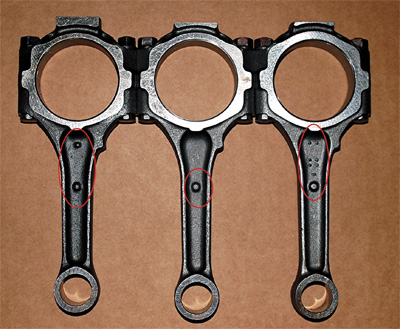Here we are starting the new year with an optimism that hasn’t been seen for probably the last five years. From all indications, 2007 appears to be the first year in a long time that will be better and show growth for the engine reman/ builder industry. The decline of the market seems to have hit bottom and a swing upward is what we have to look forward to, according many experts much wiser than myself.
As for me, I just go by the conversations with those in the PER sector of the industry and from them I agree there is a strong general consensus that things are on an upward trend. All I can say is "it’s about time."
Now that my editorial "make you feel good" is done let’s get down to the business of what you are here for: casting identification and proliferation.
This month, we will be looking at the 3.2L Isuzu V6, SOHC and DOHC, 6VD1 engine crankshafts and connecting rods. Their differences and combinations can get you in a pile of trouble if you’re not paying attention. These engines were used in a variety of different vehicles: Isuzu Amigos, Rodeos and Troopers; as well as Honda Passports and Acura SLX.
In 1992 through 1995 there were both SOHC and DOHC applications and as far as the crankshaft and connecting rods are concerned they don’t know the difference so we won’t tell them. The first
series crankshaft has a crankshaft position sensor trigger wheel in its center. It is an "as cast" part of the crankshaft and has 6 position notch locations machined into it to fire the coil packs (see Figure 1). This crank uses the shorter connecting rod that has two raised dots on the beam with a C-C length of 146mm (Figure 2). The practical builder tip for ID verification of this connecting rod is by measuring from the top of the crank pin bore to the bottom of the wrist pin bore with a caliper which is approximately 4.185" (Figure 3).
The 1996-1997 SOHC (there were no DOHC) engines still use the shorter connecting rod (Figure 2) but there is a major change made to the crankshaft: it now has a crankshaft position sensor trigger ring with notches all the way around (sorry, I did not count them all) that is a pressed-on ring with an OD of 6.937" or the smaller diameter. This is important to remember or you may experience one of those "school of hard knocks" lessons.
The 1998-2004 DOHC (yes, now the SOHC is gone) engines use a pressed on crankshaft position sensor ring that has the notches all the way around (Figure 4) but with an OD of 7.250" the larger diameter which is used in the taller deck block. Use the smaller diameter CPS trigger ring
crankshaft and the air gap will be too large for the pick-up and you’ll have no spark (see "school of hard knocks"). In addition to the taller deck block, the introduction of the longer connecting rod took place, which is identified by one dot or one dot with a bunch of little dots (Figure 2). This connecting rod has a C-C length of 152mm, with the practical builder tip (PBT) dimension of 4.420" (Figure 3).
Now we have to throw one more twist into this clearly defined confusion and that is the 3.5L engine crankshaft. This is dimensionally identical to the 1998-2004 crankshaft, other than the fact it has a longer stroke. The 3.2L engine had a 77mm stroke and the 3.5L is 85mm. Obviously if you put a 3.5 crank into a 3.2 (which you can do with no problem) you will have pistons coming out the top of the block deck.
So how do you know if it’s a 3.2L or a 3.5L crank? After looking at numerous cranks an identifier for the 3.5L was found on the first and last counterweights. There is a shallow groove machined into both of them on the OD (Figure 5). Now this can get a little tricky, because sometimes cranks may have a "tooling drag" line on the OD of the counterweights. You must make certain that the distinctive groove is present on both the first and last counterweights do not be confused by any "tool drag" mark that I also saw on many cranks.
You may have noticed that PBT’s were inserted into this Core Corner. My plan this year is to try to incorporate as many of those types of tips into Core Corner as is possible. Although they may not be what you consider true dimensional information or specific best practices, they will likely be those handy tips and procedures that you can only get from years of experience, while being mentored by some wise veteran of the industry.
My hope is that these tips will be of particular value to those in the education and Vo-Tech sector of our industry because they are the ones who can benefit the most from them. PERA is making a conscious focus to recognize the needs and interests of this sector of the industry by working alongside these technicians of the future with a mentoring attitude and dramatically reduced cost of services and subscription to EngineDataSource.com.
Special thanks go to Reggie Gray and Chris Roberts of PROFormance Powertrain Products in Springfield, MO, for their assistance in gathering and deciphering this information.














